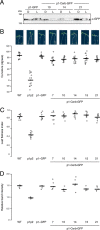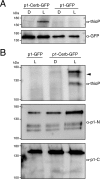A chemical genetic approach to engineer phototropin kinases for substrate labeling
- PMID: 29475950
- PMCID: PMC5900772
- DOI: 10.1074/jbc.RA118.001834
A chemical genetic approach to engineer phototropin kinases for substrate labeling
Abstract
Protein kinases (PKs) control many aspects of plant physiology by regulating signaling networks through protein phosphorylation. Phototropins (phots) are plasma membrane-associated serine/threonine PKs that control a range of physiological processes that collectively serve to optimize photosynthetic efficiency in plants. These include phototropism, leaf positioning and flattening, chloroplast movement, and stomatal opening. Despite their identification over two decades ago, only a handful of substrates have been identified for these PKs. Progress in this area has been hampered by the lack of a convenient means to confirm the identity of potential substrate candidates. Here we demonstrate that the kinase domain of Arabidopsis phot1 and phot2 can be successfully engineered to accommodate non-natural ATP analogues by substituting the bulky gatekeeper residue threonine for glycine. This approach circumvents the need for radioactivity to track phot kinase activity and follow light-induced receptor autophosphorylation in vitro by incorporating thiophosphate from N6-benzyl-ATPγS. Consequently, thiophosphorylation of phot substrate candidates can be readily monitored when added or co-expressed with phots in vitro Furthermore, gatekeeper-modified phot1 retained its functionality and its ability to accommodate N6-benzyl-ATPγS as a phosphodonor when expressed in Arabidopsis We therefore anticipate that this chemical genetic approach will provide new opportunities for labeling and identifying substrates for phots and other related AGC kinases under in vitro and near-native in vivo conditions.
Keywords: ATP; Arabidopsis; chemical genetics; gatekeeper; photobiology; photoreceptor; protein engineering; protein kinase.
© 2018 Schnabel et al.
Conflict of interest statement
The authors declare that they have no conflicts of interest with the contents of this article
Figures






Similar articles
-
Functional characterization of a constitutively active kinase variant of Arabidopsis phototropin 1.J Biol Chem. 2017 Aug 18;292(33):13843-13852. doi: 10.1074/jbc.M117.799643. Epub 2017 Jun 29. J Biol Chem. 2017. PMID: 28663371 Free PMC article.
-
Physiological roles of the light, oxygen, or voltage domains of phototropin 1 and phototropin 2 in Arabidopsis.Plant Physiol. 2007 Jan;143(1):517-29. doi: 10.1104/pp.106.089839. Epub 2006 Nov 3. Plant Physiol. 2007. PMID: 17085510 Free PMC article.
-
Functional characterization of Ostreococcus tauri phototropin.New Phytol. 2016 Jan;209(2):612-23. doi: 10.1111/nph.13640. Epub 2015 Sep 28. New Phytol. 2016. PMID: 26414490
-
Phototropins 1 and 2: versatile plant blue-light receptors.Trends Plant Sci. 2002 May;7(5):204-10. doi: 10.1016/s1360-1385(02)02245-8. Trends Plant Sci. 2002. PMID: 11992825 Review.
-
Molecular mechanism of phototropin light signaling.J Plant Res. 2016 Mar;129(2):149-57. doi: 10.1007/s10265-016-0783-6. Epub 2016 Jan 27. J Plant Res. 2016. PMID: 26815763 Review.
Cited by
-
CIPK23 regulates blue light-dependent stomatal opening in Arabidopsis thaliana.Plant J. 2020 Nov;104(3):679-692. doi: 10.1111/tpj.14955. Epub 2020 Sep 1. Plant J. 2020. PMID: 32780529 Free PMC article.
-
Bioinformatic Identification and Expression Analyses of the MAPK-MAP4K Gene Family Reveal a Putative Functional MAP4K10-MAP3K7/8-MAP2K1/11-MAPK3/6 Cascade in Wheat (Triticum aestivum L.).Plants (Basel). 2024 Mar 24;13(7):941. doi: 10.3390/plants13070941. Plants (Basel). 2024. PMID: 38611471 Free PMC article.
-
Lighting the way: Recent insights into the structure and regulation of phototropin blue light receptors.J Biol Chem. 2021 Jan-Jun;296:100594. doi: 10.1016/j.jbc.2021.100594. Epub 2021 Mar 26. J Biol Chem. 2021. PMID: 33781746 Free PMC article. Review.
-
Importance of Tyrosine Phosphorylation in Hormone-Regulated Plant Growth and Development.Int J Mol Sci. 2022 Jun 13;23(12):6603. doi: 10.3390/ijms23126603. Int J Mol Sci. 2022. PMID: 35743047 Free PMC article. Review.
-
A Comprehensive Phylogenetic Analysis of the MAP4K Family in the Green Lineage.Front Plant Sci. 2021 Aug 13;12:650171. doi: 10.3389/fpls.2021.650171. eCollection 2021. Front Plant Sci. 2021. PMID: 34484252 Free PMC article.
References
Publication types
MeSH terms
Substances
Associated data
- Actions
Grants and funding
LinkOut - more resources
Full Text Sources
Other Literature Sources
Molecular Biology Databases
Miscellaneous

